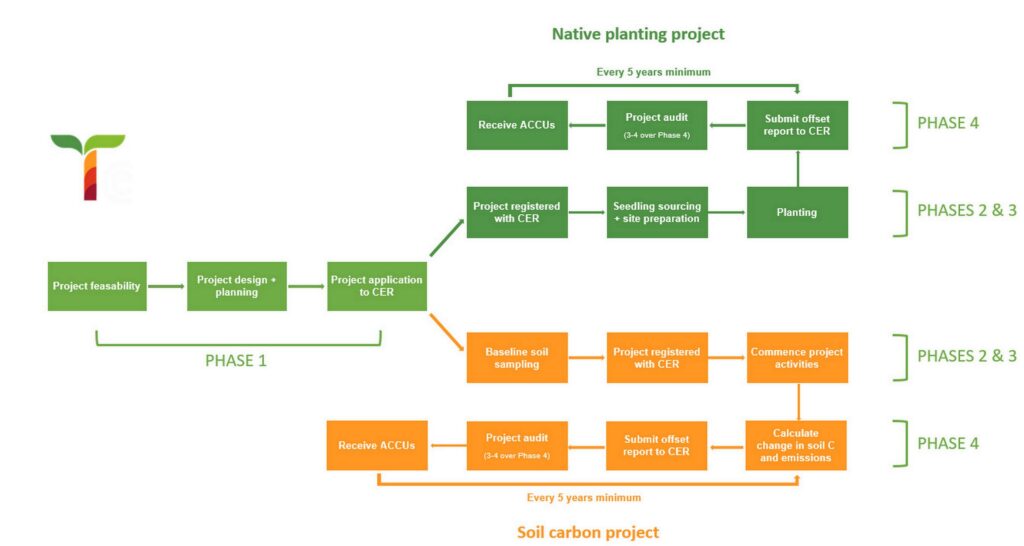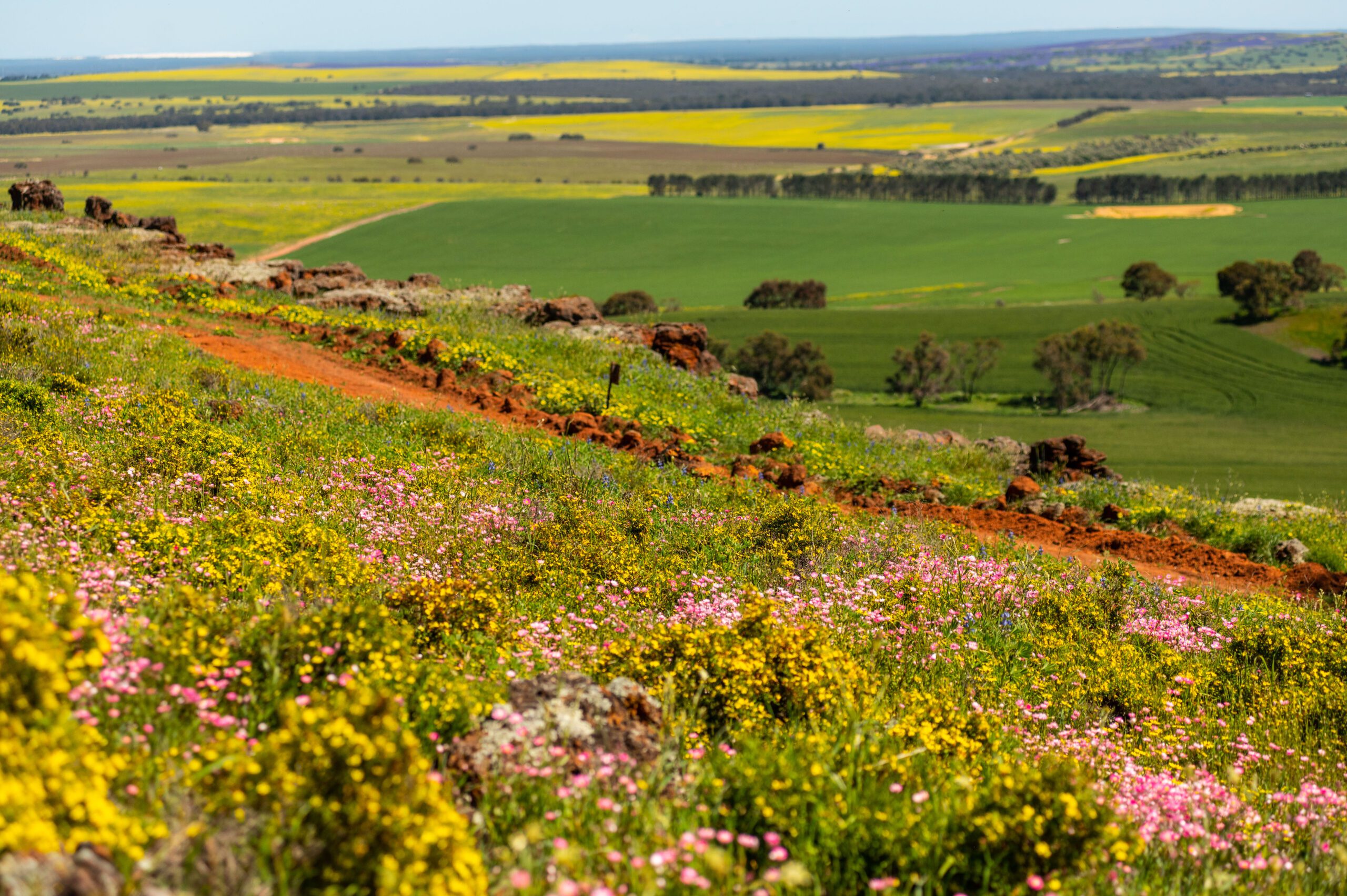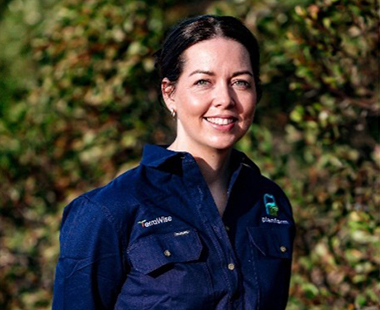We are having more and more discussions with growers who are interested in integrating carbon farming activities into their business. One of the common themes in these discussions is timing – how soon can they have a carbon project up and running? The answer, in short and with a lot of caveats, is typically a minimum of 9 months before any on-ground project activities can commence. That answer tends to come as a surprise to those who are hearing the resounding calls to action throughout the industry. The calls to action are warranted, it just takes a bit of planning to implement a carbon project.
There is a critical path to get a carbon farming project up and running, largely determined by legislative requirements. The actual path differs, dependent on the type of project (Figure 1), however, each stage typically relies on the successful completion of the prior stage.

Figure 1. Typical stages of a 25-year native planting (reforestation) or soil carbon project.
Typically, a carbon farming project involves four key phases.
1.Project feasibility, design, and planning (6+months)
A critical phase, which TerraWise coordinates, this involves:
- A high-level assessment of your land for carbon farming.
- The design and planning of your project, involving TerraWise and others (i.e., agronomists/ecologists,farm advisors, lawyers, accountants).
- The collation of all the project application information required by the Clean Energy Regulator (CER), to register your project under the Australian Carbon Credit Unit (ACCU) Scheme.
The length of Phase 1 depends on the type of carbon project (i.e., soil carbon or native plantings), its complexity and scale, your ability to contribute your time and information, and turnaround times of other parties, typically a minimum of 6 months.
2. Project registration (3 months)
To claim ACCUs from your project, it must first be registered with the ACCU Scheme:
- The CER can take up to 3 months to process and approve your application.
- You are limited as to which activities you can undertake prior to project approval.
- The premise of the ACCU Scheme is that projects are “New” and “Additional”. This is why you cannot baseline sample your soil prior to submitting your project application to the CER (though you are able to baseline sample whils your application is being assessed) and why you cannot commence any land management practices or planting activities prior to project approval.
3. Project implementation
- Once you have received project approval from the CER you can commence your project activities.
- For a soil carbon project this would be implementing the land management practices you have proposed which could increase your soil carbon levels.
- For a native plantings project this would include ordering seedlings/seed, engaging contractors, land preparation and planting. There is currently a long lead time for native seedlings in WA, a minimum of 6 months, so this needs to be factored into your project timeline.
4. Ongoing project management and reporting (project lifetime)
A carbon farming project will have a permanence period of 25 or 100 years, depending on which you nominate. You must:
- Maintain your project for the permanence period post first issuance of ACCUs.
- Submit regular reports to the CER, no more than 5 years apart, to demonstrate your project progress.
These reports are vital in determining how many ACCUs you earn. You can be strategic with the timing and frequency of your reports. You are also required to undergo third-party audits (typically 3-4) of your project over its lifespan.
Thinking of implementing a carbon farming project on your property?
Here are three key tips when it comes to project timing.
Tip one: Plan ahead.
When are you planning to implement your carbon farming project activities? Work backwards from this date, considering the timelines outlined above and give yourself a buffer period for any unforeseen obstacles that may arise. Your timeline is likely to be impacted by both project stage timelines and the calendar year.
Here are two examples of proposed timelines, given a January 2024 starting date, bearing in mind that actual timeline will depend on the specifics of a project:
EXAMPLE – NATIVE PLANTINGS PROJECT
Scenario: The landowner wishes to register a native plantings project on their property under the ACCU scheme. They intend to plant biodiverse native species for this project and the optimal planting window for their region is July to August. Their indicative timeline to planting could look like this:

A couple of important points here:
- The landholder’s timeline is dictated by their planting window in July/August of any given year, irrespective of when they commence the process.
- The actual timeline from initial contact to planting, not considering calendar year restrictions, could range from 12-18 months. This is largely determined by Phase 1 (How much time can the landholder contribute to the design and planning stages? What is the turnaround time of other project parties?) and access to seedlings (Is there a secure immediate supply or will there be a lead time for propagation?).
EXAMPLE – SOIL CARBON PROJECT
Scenario: The landowner wishes to register a soil carbon project across their property under the ACCU scheme. They intend to undertake claying and spading activities, along with amended fertiliser management. Their indicative timeline to practice implementation could look like this:

A few important points here:
- The landholder’s timeline is dictated by both project-specific timelines and the production calendar.
- In this example the landholder is implementing cropping centric practices, however if this considered livestock centric practices, they would likely be able to be implemented sooner.
- Though baseline sampling could occur in July 2024 when the application to CER is submitted, the landholder doesn’t commence sampling until post-harvest in 2025. Though it is possible to baseline sample during the growing season, the logistics of accessing cropped paddocks may render this impractical. Baseline soil sampling outside of the growing season can also cater for possible seasonal fluctuations in soil carbon – be strategic with your baseline.
- The actual time from initial contact to first implementation of management practices, not considering production year restrictions, can be as low as 9 months. Though it might be easier to present an
example with tidy timelines here, it’s important to look at actual implications considering the calendar year.
Tip two: Be prepared.
As the above examples show, timing is key. With so many stages dependent on the completion of the prior for you to proceed, preparation will set you up for success. Each project is different. The workloads will differ across projects, dependent on project scale, complexity, proposed project activities, access to data, amongst other factors.
Do your research, engage with service providers who set you up for a smooth process through each stage and navigate any obstacles. Being prepared in Phase 1 will serve you well in Phase 2, so you can hit the ground running in Phase 3, with the implementation of your carbon project.
Tip three: Don’t be daunted.
There’s no avoiding it, commencing a carbon farming project can be complex. This is the nature of working within a legislated process, whilst ensuring a scientifically rigorous project and of course, a project that integrates into your business both now, and into the future. Thus, the importance of working with a project partner who will shoulder most of the administrative burden and simplify the process to ensure a smooth run.
It can be tempting to think it’s easier to sit back and wait, but remember, even if you started the process today, the earliest you would likely see any ACCUs from your carbon farming project would be post 2027. If you are thinking about what carbon farming could mean for your business, either from a future income perspective, an offset of your own carbon emissions perspective, a sustainability and farm resilience
perspective, or all the above, there’s no time like the present to get that ball rolling.


